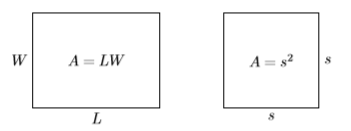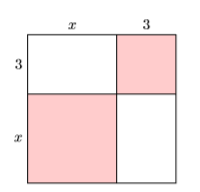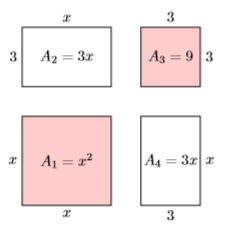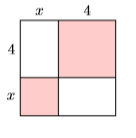5.4: Sumando y restando polinomios
( \newcommand{\kernel}{\mathrm{null}\,}\)
En esta sección nos concentramos en sumar y restar expresiones polinómicas, a partir de trabajos anteriores combinando términos similares en Poderes Ascendente y Descendente. Comencemos con un ejemplo de adición.
Ejemplo5.4.1
Simplificar:(a2+3ab−b2)+(4a2+11ab−9b2)
Solución
Utilice las propiedades conmutativas y asociativas para cambiar el orden y reagruparse. Después combina términos similares.
(a2+3ab−b2)+(4a2+11ab−9b2)=(a2+4a2)+(3ab+11ab)+(−b2−9b2)=5a2+14ab−10b2
Ejercicio5.4.1
Simplificar:(3s2−2st+4t2)+(s2+7st−5t2)
- Responder
-
4s2+5st−t2
Combinemos algunas funciones polinómicas.
Ejemplo5.4.2
Dadof(x)=3x2−4x−8 yg(x)=x2−11x+15, simplificarf(x)+g(x).
Solución
Primero, sustituirf(x) yg(x) con sus definiciones. Asegúrese de rodear cada polinomio con paréntesis, porque se nos pide que agreguemos todof(x) a todosg(x).
f(x)+g(x)=(3x2−4x−8)+(x2−11x+15)Ahora usa las propiedades conmutativas y asociativas para cambiar el orden y reagruparse. Combina términos similares.
=(3x2+x2)+(−4x−11x)+(−8+15)=4x2−15x+7
De ahí,f(x)+g(x)=4x2−15x+7.
Ejercicio5.4.2
Giv esf(x)=2x2+9x−5 yg(x)=−x2−4x+3, simplify f(x)+g(x).
- Responder
-
x2+5x−2
Si te sientes cómodo saltando uno o dos pasos, no es necesario anotar todos los pasos que se muestran en Ejemplos5.4.1 y5.4.2. Intentemos combinar mentalmente términos similares en el siguiente ejemplo.
Ejemplo5.4.3
Simplificar:(x3−2x2y+3xy2+y3)+(2x3−4x2y−8xy2+5y3)
Solución
Si usamos la propiedad asociativa y conmutativa para reordenar y reagruparnos, luego combinamos términos similares, obtenemos el siguiente resultado.
(x3−2x2y+3xy2+y3)+(2x3−4x2y−8xy2+5y3)=(x3+2x3)+(−2x2y−4x2y)+(3xy2−8xy2)+(y3+5y3)=3x3−6x2y−5xy2+6y3
Sin embargo, si podemos combinar mentalmente términos similares, eliminando el paso medio, es mucho más eficiente escribir:
(x3−2x2y+3xy2+y3)+(2x3−4x2y−8xy2+5y3)=3x3−6x2y−5xy2+6y3
Ejercicio5.4.3
Simplificar:(−5a2b+4ab−3ab2)+(2a2b+7ab−ab2)
- Responder
-
−3a2b+11ab−4ab2d
Negando un polinomio
Antes de intentar restar polinomios, abordemos primero cómo negar o “tomar lo contrario” de un polinomio. Primero recordemos que negar equivale a multiplicar por−1.
Negando
Sia hay algún número, entonces
−a=(−1)a.
Es decir, negar equivale a multiplicar por−1.
Podemos utilizar esta propiedad para simplificar−(a+b). Primero, negar es idéntico a multiplicar por−1. Entonces podemos distribuir el−1.
−(a+b)=(−1)(a+b) Negating is equivalent to multiplying by −1=(−1)a+(−1)b Distribute the −1.=−a+(−b) Simplify: (−1)a=−a and (−1)b=−b=−a−b Subtraction means add the opposite.
Así,−(a+b)=−a−b. Sin embargo, probablemente sea más sencillo señalar que el signo menos frente a los paréntesis simplemente cambió el signo de cada término dentro de los paréntesis.
Negando una suma
Al negar una suma de términos, el efecto del signo menos es cambiar cada término entre paréntesis al signo opuesto. −(a+b)=−a−b
Veamos este principio en el siguiente ejemplo.
Ejemplo5.4.4
Simplificar:−(−3x2+4x−8)
Solución
Primero, negar equivale a multiplicar por−1. Después distribuir el−1.
−(−3x2+4x−8)=(−1)(−3x2+4x−8)Negating is equivalent to multiplying by −1=(−1)(−3x2)+(−1)(4x)−(−1)(8)Distribute the −1=3x2+(−4x)−(−8)Simplify: (−1)(−3x2)=3x2,(−1)(4x)=−4x,and(−1)(8)=−8=3x2−4x+8Subtraction means add the opposite.
Solución alternativa:
Como vimos anteriormente, un signo negativo frente a un paréntesis simplemente cambia el signo de cada término dentro de los paréntesis. Por lo que es mucho más eficiente escribir−(−3x2+4x−8)=3x2−4x+8 simplemente cambiando el signo de cada término dentro de los paréntesis.
Ejercicio5.4.4
Simplificar:−(2x2−3x+9)
- Responder
-
−2x2+3x−9
Restar polinomios
Ahora que sabemos negar un polinomio (cambiar el signo de cada término del polinomio), estamos listos para restar polinomios.
Ejemplo5.4.5
Simplificar:(y3−3y2z+4yz2+z3)−(2y3−8y2z+2yz2−8z3)
Solución
Primero, distribuir el signo menos, cambiando el signo de cada término del segundo polinomio.
(y3−3y2z+4yz2+z3)−(2y3−8y2z+2yz2−8z3)=y3−3y2z+4yz2+z3−2y3+8y2z−2yz2+8z3
Reagruparse, combinando términos similares. Puedes realizar este siguiente paso mentalmente si lo deseas.
=(y3−2y3)+(−3y2z+8y2z)+(4yz2−2yz2)+(z3+8z3)=−y3+5y2z+2yz2+9z3
Ejercicio5.4.5
Simplificar:(4a2b+2ab−7ab2)−(2a2b−ab−5ab2)
- Responder
-
2a2b+3ab−2ab2
Vamos a restar dos funciones polinómicas.
Ejemplo5.4.6
Dadop(x)=−5x3+6x−9 yq(x)=6x2−7x−11, simplificarp(x)−q(x).
Solución
Primero, sustituirp(x) yq(x) con sus definiciones. Debido a que se nos pide restar todoq(x) de todosp(x), es fundamental rodear cada polinomio con paréntesis.
p(x)−q(x)=(−5x3+6x−9)−(6x2−7x−11)
Distribuye el signo menos, cambiando el signo de cada término en el segundo polinomio, luego reagrupa y combina términos similares.
=−5x3+6x−9−6x2+7x+11=−5x3−6x2+(6x+7x)+(−9+11)=−5x3−6x2+13x+2
Sin embargo, después de distribuir el signo menos, si podemos combinar mentalmente términos similares, eliminando el paso medio, es mucho más eficiente escribir:
p(x)−q(x)=(−5x3+6x−9)−(6x2−7x−11)=−5x3+6x−9−6x2+7x+11=−5x3−6x2+13x+2
Ejercicio5.4.6
Dadof(x)=3x2+9x−4 yg(x)=−5x2+4x−6, simplificarf(x)−g(x).
- Responder
-
8x2+5x+2
Algunas aplicaciones
Recordemos que el área de un rectángulo que tiene longitudL y anchuraW se encuentra usando la fórmulaA=LW. El área de un cuadrado que tiene lado s se encuentra usando la fórmulaA=s2 (ver Figura5.4.1).

Ejemplo5.4.7
Encuentra el área del cuadrado en la Figura5.4.2 sumando el área de sus partes.

Solución
Separar cada una de las cuatro piezas y etiquetar cada una con su área (ver Figura5.4.3).

Los dos cuadrados sombreados en la Figura5.4.3 tienen áreasA1=x2 yA3=9, respectivamente. Los dos rectángulos no sombreados en la Figura5.4.3 tienen áreasA2=3x yA4=3x. Sumar estas cuatro áreas nos da el área de toda la figura.
A=A1+A2+A3+A4=x2+3x+9+3x=x2+6x+9
Ejercicio5.4.7
Encuentra el área del cuadrado que se muestra a continuación sumando el área de sus partes.

- Responder
-
x2+8x+16
Ejemplo5.4.8
Ginger dirige un negocio de venta de canastas de mimbre. Sus costos de negocio para producir y vender cestas dex mimbre vienen dados por la función polinómicaC(x)=100+3x−0.02x2. El ingreso que obtiene al vender canastas dex mimbre viene dado por la función polinómicaR(x)=2.75x. Encuentra una fórmula paraP(x), el profit hecho a partir de la venta de cestasx de mimbre. Usa tu fórmula para determinar el perfil de Ginger si vende canastas123 de mimbre.
Solución
El profit hecho de la venta de cestas dex mimbre se encuentra restando los costos incurridos de los ingresos recibidos. En símbolos:P(x)=R(x)−C(x)
Siguiente, reemplaceR(x) yC(x) con sus definiciones. Debido a que se supone que debemos restar todo el costo de los ingresos, asegúrese de rodear el polinomio de costos con paréntesis. P(x)=2.75x−(100+3x−0.02x2)
Distribuye el signo menos y combina términos similares.
=2.75x−100−3x+0.02x2=0.02x2−0.25x−100
Así, la función profit esP(x)=0.02x2−0.25x−100.
A continuación, para determinar el profit si se venden cestas de123 mimbre, sustituya123x en la función profitP(x).
P(x)=0.02x2−0.25x−100P(123)=0.02(123)2−0.25(123)−100
Ahora puedes usar tu calculadora gráfica para determinar el perfil (ver Figura5.4.5). De ahí que el profit hecho a partir de la venta de canastas de123 mimbre es$171.83.

Ejercicio5.4.8
Los costos de producción y venta dex widgets are given by the polynomial function C(x)=50+5x−0.5x2, and the revenue for selling x widgets is given by the polynomial function R(x)=3.5x. Determine the profit si75 widgets are sold.
- Responder
-
$2,650


